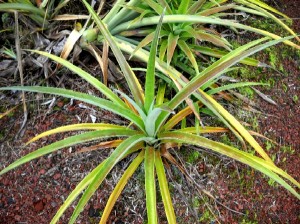Bromeliad Care
Vital Guidelines to Caring for Bromeliad Plants
Bromeliad plants are some of the most exotic plants in the world and they are easy to grow. But one simple little mistake with watering can kill your beautiful bromeliad plant. So keep reading if you want to avoid making this common rookie mistake.
Bromeliad plants are members of the Bromeliaceae family, which includes the most famous bromeliad of them all: the pineapple. Bromeliads grow well indoors and come in a wide variety of colors. They are cherished because of the stunning flowers that they produce from the center of their rosette.
 Proper bromeliad care involves addressing the following factors to ensure that your bromeliad plant stays healthy and grows well. The factors are:
Proper bromeliad care involves addressing the following factors to ensure that your bromeliad plant stays healthy and grows well. The factors are:
- Water
- Light
- Temperature
- Humidity
- Air Circulation
- Feeding
Watering a Bromeliad Plant
Over the years, Bromeliads plants have adapted to survive harsh drought conditions and so they can handle periods of low moisture very well. You are much more likely to harm your plant by over watering it than by under watering it. Over watering your bromeliad plant can cause root rot and when root rot is left unchecked it can kill your bromeliad.
You should wait until the surface of your bromeliad’s potting mix begins to feel dry and then you should water it thoroughly until water comes out from the bottom of the pot. This will flush any excess salts out of the potting mix. If you don’t water your plant completely, salts will build up and harm your plant.
Bromeliad plants store water in the center of their rosettes, but in most instances you should avoid allowing water to collect in the center of your bromeliads for a number of reasons. First, standing water can stagnate and cause your plant to get a bacterial or fungal infection. Second, when your plant is exposed to low temperatures the water can freeze or serve to retain the cold temperature and cause your plant to be damaged by frost. Third, your plant can get all the water it needs through its root system, so there is no pressing need to put any water in its rosette.
If you have an epiphytic bromeliad that is attached to a piece of wood or a tree, it will lack a rosette and a large root system, so it will have a harder time getting the moisture it needs. You must make sure that you mist it with water regularly so that it receives the moisture that it needs to grow.
Finally, one rookie watering mistake that can kill your bromeliad is watering it with a metal watering can. Bromeliads are very sensitive to metals and using a metal watering can may harm or even kill your plant.
Light levels and Bromeliads
 Most bromeliads can tolerate a wide variation in light levels, but to look they need the right amount of light. In general, bromeliad varieties with thick, hard, gray leaves tend to like higher levels of sunlight, while varieties with thin, green, soft leaves like lower levels of sunlight. When growing your plant indoors any area with bright light, as long as it is not direct sunlight is best for your plant.
Most bromeliads can tolerate a wide variation in light levels, but to look they need the right amount of light. In general, bromeliad varieties with thick, hard, gray leaves tend to like higher levels of sunlight, while varieties with thin, green, soft leaves like lower levels of sunlight. When growing your plant indoors any area with bright light, as long as it is not direct sunlight is best for your plant.
To find out if your bromeliad is receiving the right amount of light look at its leaves. If your plant’s leaves are getting paler or more yellow, your plant may be receiving too much light. Conversely, if your plant’s leaves are becoming a darker shade of green and stretching or elongating, your plant may be receiving too little light. A helpful tip is to periodically snap digital photos of your plant to use as a comparison. But always take these photos under the same artificial light source or the colors may be distorted.
Air Temperature
Unless the area you live in has temperatures that exceed 100 degrees your bromeliad plant will probably be fine on the high end of the temperature scale. Usually the low end of the temperature scale is where most bromeliad growers run into problems. There are a few varieties of bromeliads that can survive short exposure to temperatures of 32 degrees, but in general 40 degrees is the lowest temperature a bromeliad can be exposed to. If you are growing a bromeliad indoors, you should strive to keep the temperature between 60 and 75 degrees. Bromeliads like temperatures of 65 degrees at night and 75 degrees during the day.
Bromeliad plants with soft leaves prefer higher temperatures, while bromeliads with tough leaves are able to handle lower temperatures a little better.
Humidity Levels
A relative humidity level of 50% is ideal for most types of bromeliads. And a range of 40 to 60 percent is best. If the humidity in your home is lower than this, you should consider installing a humidifier near your bromeliad plant. This will add moisture to the air and allow your bromeliad to thrive. Another option is to mist your plant with water regularly, and yet another option is to set the pot of your bromeliad upon a layer of gravel that is soaked with water. But remember the water level should never encroach on the base of the pot. If it does, capillary action will pull water into your bromeliad’s potting mix and cause it to become water logged. Please refer to the section on watering your bromeliad if you don’t already know why this is bad for your bromeliad plant.
Air Circulation: Good for people and for Bromeliads Too
You probably like good air circulation and hate stale air. Well your bromeliad plant is much like you. It doesn’t like poor air circulation either. Good air circulation is vital for keeping your bromeliad healthy. It will prevent the growth of fungus and alleviate attacks by various species of scale insects. You can ensure good air circulation with a small fan or by simply opening the windows of your home on a temperate day. You’ll breathe easier and so will your bromeliad plant.
Feeding your Bromeliad Plant
Just like you, your bromeliad needs to eat too. Only it doesn’t need to eat as often. In general, you should fertilize it when it is actively growing and hold back on fertilizing it when it is not growing, which generally happens during the winter time. During the spring and summer growing season apply a liquid fertilizer to the potting mix once every two months. Make sure that you dilute the liquid fertilizer to 33% of the recommended strength, because bromeliads don’t like to over eat.
When applying the fertilizer, be very careful not to get it into the rosette. If this happens, salts can build up in the rosette and harm your bromeliad plant. These salts can inflict painful burns on newly emerging leaves.
Subscribe to my free newsletter and learn:
- The 3 most important things you must do to keep your new bromeliad alive
- How to water your bromeliad properly, so it isn’t harmed by excess salts or bacterial growth
- When to repot your bromeliad and how to avoid killing it during the repotting process
Rare Bromeliad Plants
Are you interested in buying rare bromeliad plants?
One of the foremost bromeliad breeders in the world is located a few blocks away from our farm. He has given talks about bromeliads to other bromeliad breeders around the world and he is the expert that other bromeliad breeders and growers look to when they need advice about bromeliads.
My parents have known him for several decades and he recently reminded me that he knew me since I was less than two feet tall. (Yes, I was only a few years old at the time.)
He has been developing exotic new varieties of bromeliads for a number of decades and he has quite a few varieties which are exceptionally rare, because he personally hybridized them.
I’m thinking of adding a few of these incredibly rare bromeliads to our catalog, but only if there is interest. I would expect prices to range from $75 to $150 and up to $275 (in a few exceptional cases) per plant.
Do you have interest in acquiring any of these exceptionally exotic bromeliads?
If you are, please use our contact form to let me know.
Amazon Bestsellers: Bromeliads
